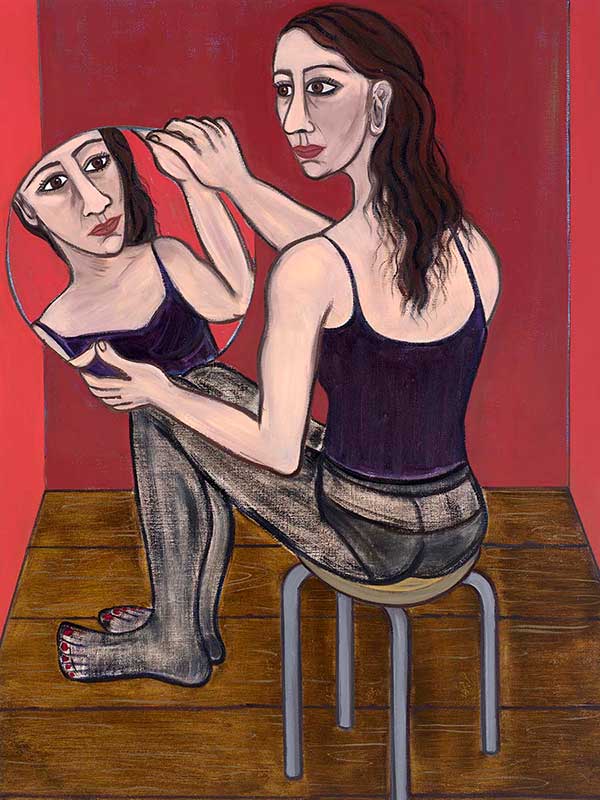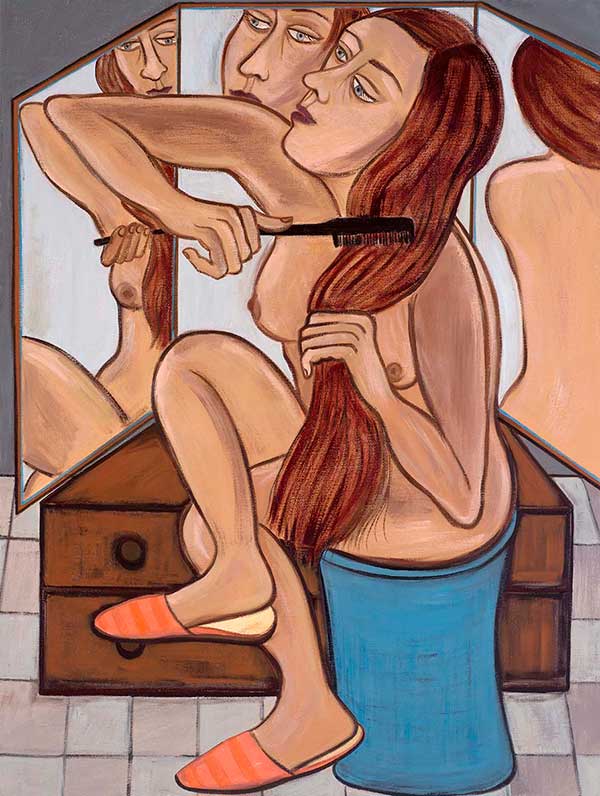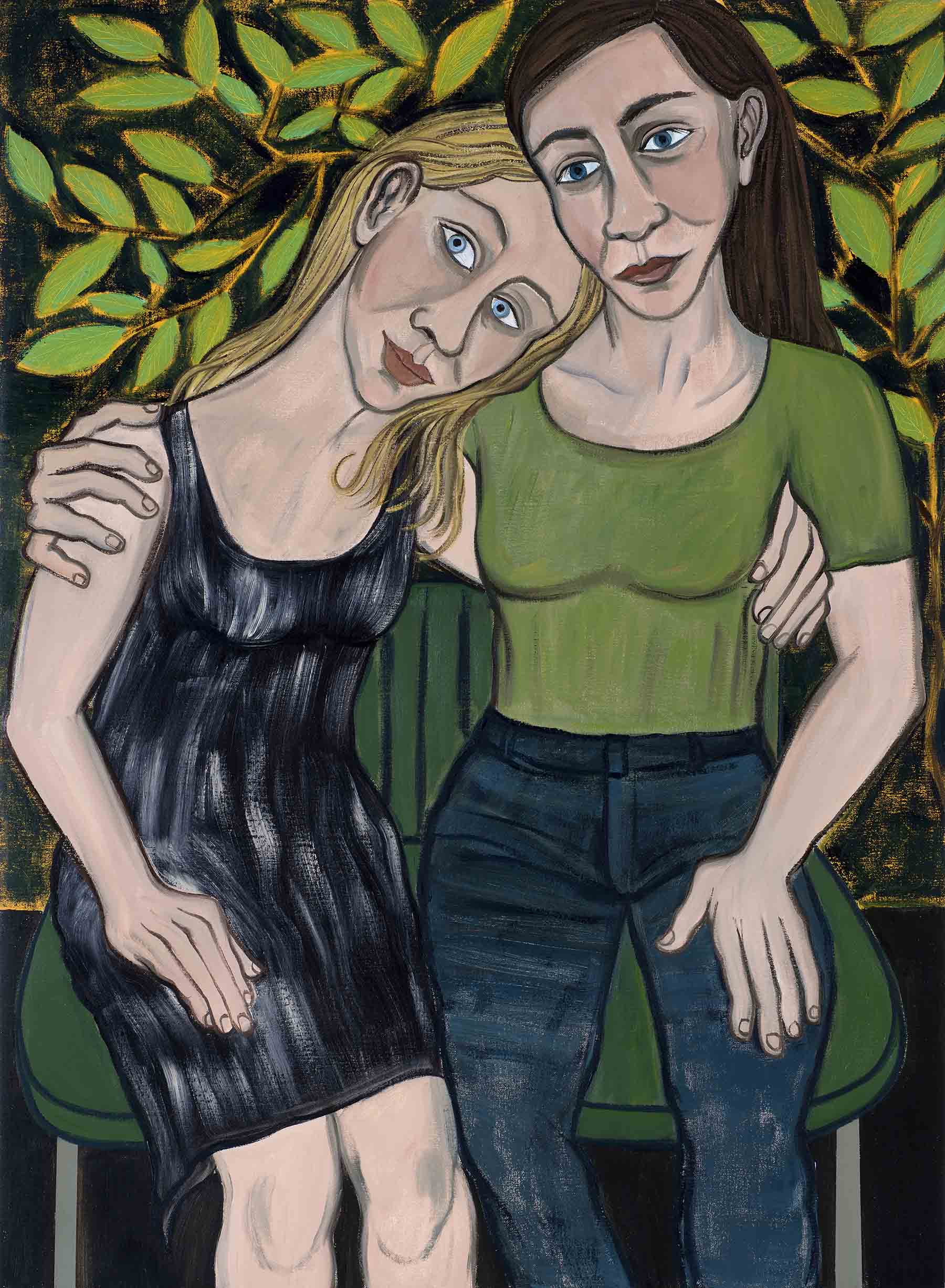Cooper depicts human vulnerabilities, emotions and relationships as modern myths, with her own visual language that sees her protagonists and their companions playing symbolic or totemic roles

‘Personal Space’ is a phrase with a multiplicity of meaning, but for Eileen Cooper, who has always painted the female figure, the phrase alludes to the inner life of her subjects, and the complex search to find one’s own identity. The women in Cooper’s latest body of work are depicted in nurturing and intimate spaces, their inner lives explored with confidence, sensitivity and awareness.
Through these images, Cooper revisits and expands on themes that she has explored throughout her forty-year career, those of universal female experience, primarily fertility, sexuality and motherhood. In this latest body of work, Cooper has also incorporated images celebrating friendship and sisterhood, and those bonds created when we let others into our private and emotional worlds. The images also explore the notion of burgeoning self-awareness and self-assuredness that develops as we mature and of the moments of tranquility that can be found when completely alone.
The paintings depict female figures in private spaces, engaged in intimate and sometimes simple acts, including brushing or washing hair or applying make up. Through these works, Cooper investigates the rhythms and rituals of ‘getting ready’; of constructing the version of ourselves we would like to present to the outside world. These images distil many of the themes that interest Cooper, and by depicting these very personal, yet quotidian, acts allows Cooper to explore deeper elements of female identity and subjectivity, opening a door into the inner world of her protagonist’s psyches.
Many of the images have complex surfaces, in which the main figures are multiplied by their reflections in the mirrors that surround them. The repetition of this motif underpins Cooper’s interest in self-reflection and self-image, of the affirmation or self doubt that occurs when confronting one’s own reflected image. In Every Mother’s Son, the two protagonists stand back to back, yet their reflected image shows them almost merged into one form, revealing the contrast between subjective and objective truth. In the painting Personal Space, Cooper further explores this idea with a particularly complex composition depicting a nude figure combing her long hair, enveloped by a series of three angled mirrors, each showing just a fragment of her face or body. This fractured depiction perhaps intimates the multiple roles that a woman plays in her life, or the multiple selves that exist within her.

Personal Space, 2019. Eileen Cooper
Cooper sees the mirror as a symbol of a quest for self-knowledge. Although often isolated in claustrophobic interior spaces, the subjects in Cooper’s paintings are confident and purposeful, gazing stridently out at the viewer or at their own figures in the mirror. This repeated element highlights Cooper’s own reflection on her career to date, on the image of her as creator, as artist, and as a woman. The series represents a time of great change in her artistic practice, as she has shifted from an internal, intuitive process to one rooted in ‘information gathering’, as she calls it; in observation and drawing from life.
Although not strictly representational, this latest body of work follows an intensive year of drawing directly from life. After a lifetime of working from her imagination, Cooper’s renewed interest in direct observation has seen her produce a wealth of lyrical charcoal portraits made on paper, often of women she has close relationships with, or artists she has previously taught. Cooper was then able to rework and reimagine these drawings onto canvas, the figures stripped of their defining features, but retaining an essential and lifelike essence. The resulting imagery explores the powerful tension created between the universal and the particular, and of the real and the imagined.
Cooper has skilfully blended this new element of her practise with her characteristic use of graphic, decisive line, flattened space and bold colour palette. Her compositions are neither a straight description of reality or a directly imagined world, and the painted figures slip in and out of straight portraiture, settling somewhere close to lively and believably breathing archetypes. The figures are, as they always have been in Cooper’s oeuvre, defined largely by their bold outlines, but here they receive more internal modelling, and the variety in their features is a marked departure from earlier works.
The evolution of Cooper’s artistic career can be traced through this gradual return to the life model, from which she turned away from while still at art school. The wild and expressionistic reds and purples of her protagonist’s naked skin in the 1980s and 1990s gradually paled into lifelike tones and their limbs eventually even acquired clothes in the 2000s. Works included in ‘Personal Space’ see the tigers and tortoises of earlier canvases morph into domestic animals. There has been no joy lost in Cooper’s images during this change, however. Her figures are still imbued with a vitality and strength of spirit that emanates through the brushstrokes. There is a universal humanness embedded in her subjects, which has remained a constant, even as elements of verisimilitude have begun to take prescience.
Cooper’s compositions, too, remain rigorously formal, as the figures continue to exist in a shallow and simplified ambiguous space. The language of symbol, myth and allegory permeate these paintings, as it has throughout her career’s work. The stillness of the figures and the directness of their gestures speak of the Medieval and Moghul art that has always inspired her. The central figure in Lipstick, in particular, in her stark frontality, is rendered as an icon. Her limbs are placed deliberately, holding her mirror and lipstick in each hand, as would a saint clutching their attributes on a Sienese altarpiece. The compositions of Sentimental Mood, Learning To Read and Child are certainly all informed by the tradition of Madonna and Child.
By working in this mode, Cooper creates poignant imagery that represents universal female experience. By depicting its accompanying rituals, Cooper reveals many aspects of modern femininity and identity to be performance. However, the forging of physical and emotional bonds, including the experience of motherhood, is approached as something intimate and powerful. Cooper depicts human vulnerabilities, emotions and relationships as modern myths, with her own visual language that sees her protagonists and their companions playing symbolic or totemic roles.
This body of work, driven by drawing, has allowed Cooper to turn over the possibilities of observation, without letting realism dominate or cloud her singular objective. Realism and truth do not, and have never suited, Cooper’s primary purpose. This is to reveal something deeper and wider, something universal
(By Thea Gregory)
